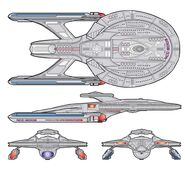The Luna-class was a type of Federation reconnaissance science vessel put into service by Starfleet in the latter 24th century.
History[]
Development[]
The Luna Class Development Project was initiated in 2369 in response to the discovery of the Bajoran Wormhole. The class was originally conceived of as leading a wave of deep-space exploration by Starfleet into the Gamma Quadrant. Project engineers took lessons learned from the Nova, Alliance, and Kelvin-classes, and expanded upon them to create a deep space exploration vessel that could conduct effective exploration missions, with the ability to look after itself in unknown space.
The project was spearheaded by Dr. (Commander) Xin Ra-Havreii, a Starfleet theoretical engineer at Utopia Planitia. Field testing on the prototype USS Luna was under way by 2372 in the Alpha Quadrant, and construction of the class was scheduled to begin the following year. Unfortunately, contact with the Dominion and the subsequent outbreak of hostilities mothballed the project indefinitely, as Starfleet redirected its shipbuilding resources to the production of vessels better suited for combat. Only the USS Luna had been completed. She was assigned to Starbase 400 near the Federation borders with the Klingon and Romulan Empires.
Post-Dominion War[]
Upon the war's end in late 2375, Dr. Ra-Havreii correctly judged that the Federation's cultural psychology would eventually shift back toward its pre-war ideals, and pushed to have the Luna-class revisited as a major step toward resuming Starfleet's mission of peaceful exploration (even though the class would no longer be assigned exclusively to the exploration of the Gamma Quadrant). Construction of an initial group of twelve Luna-class vessels was completed by 2378, and the USS Titan was offered to William T. Riker, one of many command officers eager to put the strife of the last decade behind them.
Technical information[]
Subclasses[]
Polaris[]
Compared to the standard Luna, the Polaris subclass was very abrasive. The aft section of the mission pod, main hull, and nacelles led into a spiked design. The saucer section was quite typical in design, although it was longer than most of the other variants and had notable cut-outs on the aft sides.
Sol[]
The Sol-subclass featured a very smooth and rounded design with little in the way of sharp edges. The saucer design was pear-shaped with the wider portion at the rear. The dorsal section of the hull was comprised of a smooth slope going from the saucer section to the aft section of the hull and also was the main entry point for shuttles.
Comet[]
The Comet-subclass was an evolution of the Sol-class. The starship's nacelle pylons were forked and the pod and saucer section were much more connected than other vessels of the Luna line.
USS Admonitor[]
The USS Admonitor, a Hikaru-class explorer vessel made in secret in 2340, bears some resemblance to the Luna-class. This is considered entirely coincidental, since according to Starfleet records, the Admonitor doesn't exist.
Ships commissioned[]
- Main article: Category:Luna class starships
- USS Callisto (NCC-80109)
- USS Comet (prototyp Comet-class, NX-83103)
- USS Luna (prototype, NX-80101)
- USS Polaris (prototype Polaris-class, NCC-92515)
- USS Sol (prototype Sol-class, NCC-89931)
- USS Titan (NCC-80102)
- USS Armstrong (NCC-16769)
- USS Endeavour (NCC-92485)
Gallery[]
Appendices[]
External links[]
- Luna class article at Memory Beta, the non-canon Star Trek wiki.
- Reconnaissance Science Vessel article at The Star Trek Online Wiki.
- Luna class article at Star Trek Expanded Universe.

